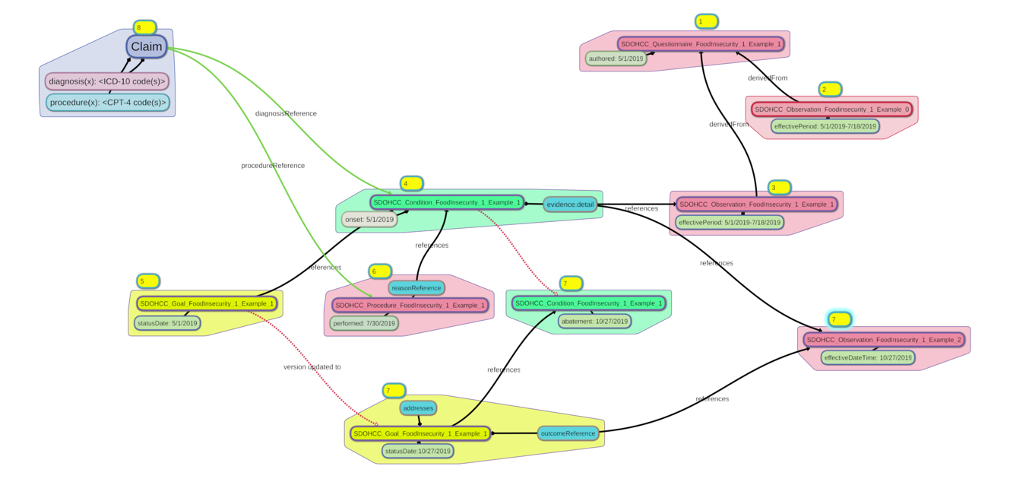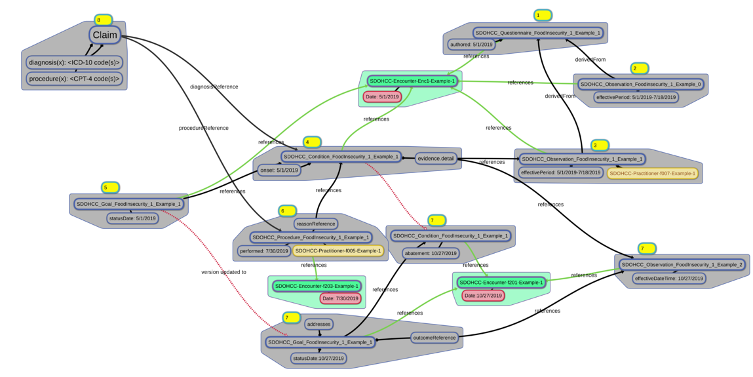SDOH Clinical Care - Local Development build (v0.0.4C1). See the Directory of published versions
About SDOH-CC Food Insecurity Standardized Data Exchange Examples
Previous Page - About SDOH-CC IdentifierSystem Temporary Identifiers
This IG defines a collection of profiles for representing screening information for food insecurity and documenting clinical data related to food insecurity which a clinician would record during a patient visit. It also defines profiles that support making a referral for services to address food insecurity and supplying feedback about a completed referral. Recording and sharing coded SDOH information improves how data can be used.
The example demonstrates how the SDOH-CC profiles supports four common uses of coded data.
- Document Screening results digitally to allow them to be included in the patient’s electronic health record.
- Record SDOH Data in a way that aligns with the existing clinical data paradigm
- Share SDOH referral information to connect the clinical setting with community-based support services
- Gather SDOH information at the point of care and re-use the data to support quality measurement, research, and public or population health
- Align with financial models, support claims payment, and the accelerate the shift toward value-based care
Patient is screened for food insecurity prior to appointment. Screening informaiton is available to clinicaian at point care to support clinical assessment of the patient’s conditions.
- SDOHCC-QuestionnaireResponse-HungerVitalSign-1-Example-1 is used as an instrument to assess food insecurity.
- SDOHCC_Observation_Foodinsecurity_1_Example_0 (STILL IN DEVELOPMENT) is a computed observation based on QuestionnaireResponse.
Patient is seen in the office, 5/1/2019, and reports food insecurity that began about a month ago.
- SDOHCC_Observation_FoodInsecurity_1_Example_1 is created.
- SDOHCC_Condition_FoodInsecurity_1_Example_1 is created, and references SDOHCC_Observation_FoodInsecurity_1_Example_1.
- SDOHCC_Goal_FoodInsecurity_1_Example_1 is created, and references SDOHCC_Condition_FoodInsecurity_1_Example_1.
An intervention for social service assistance is requested.
Patient is seen by social services, 7/30/2019
- SDOHCC_Procedure_FoodInsecurity_1_Example_1 is performed, and references SDOHCC_Condition_FoodInsecurity_1_Example_1.
Patient is seen back in the office, 10/27/2019, and reports resolution of food insecurity.
- SDOHCC_Observation_FoodInsecurity_1_Example_2 is created, documenting absence of food insecurity.
SDOHCC_Condition_FoodInsecurity_1_Example_1 is updated to reflect that condition is now in remission, and adds a reference to SDOHCC_Observation_FoodInsecurity_1_Example_2.
SDOHCC_Goal_FoodInsecurity_1_Example_1 is updated to reflect that goal is achieved, and adds a reference to SDOHCC_Observation_FoodInsecurity_1_Example_2.
<table><tr><td> </td></tr></table>
</td></tr></table>
Share SDOH referral information to connect the clinical setting with community-based support services
STILL IN DEVELOPMENT
- SDOHCC_ServiceRequest_FoodInsecurity_1_Example_1
STILL IN DEVELOPMENT
Gather SDOH information at the point of care and re-use the data to support quality measurement, research, and public or population health
STILL IN DEVELOPMENT
- Mind Map about eCQM
Align with financial models, support claims payment, and the accelerate the shift toward value-based care
STILL IN DEVELOPMENT
- Mind Map about Claims
Example 2:
The diagram below illustrates the same scenario from the perspective of three different encounter dates. It illustrates the capture of data provenance for the procedures performed on 7/30/2019, [date #2] and [date #3].
 </td></tr></table>
</td></tr></table>